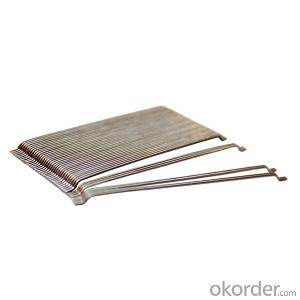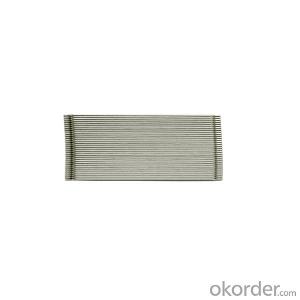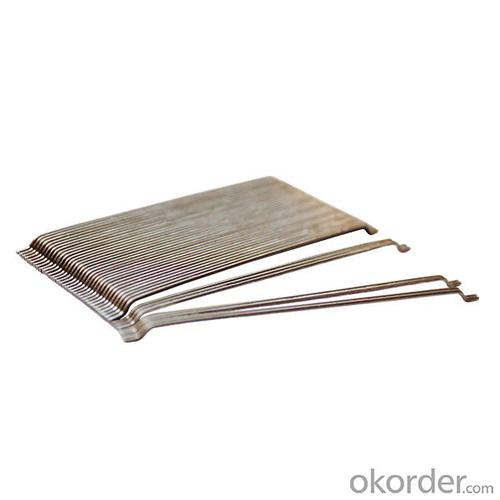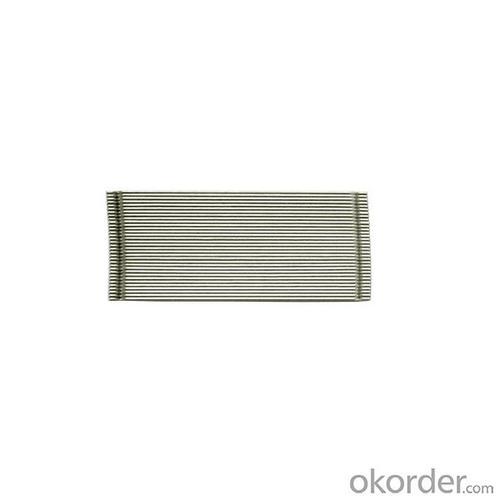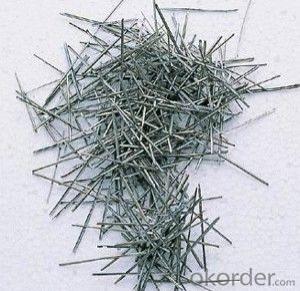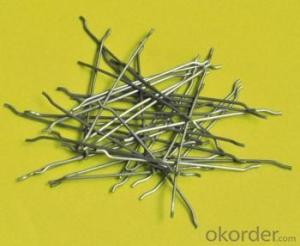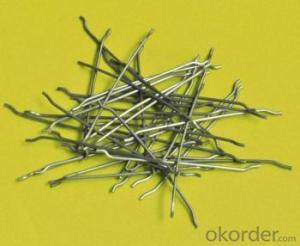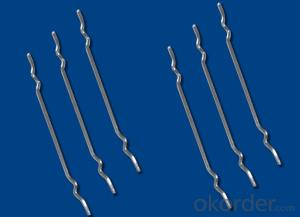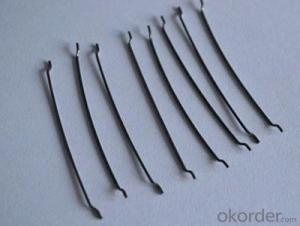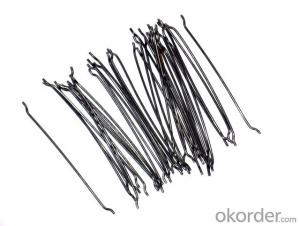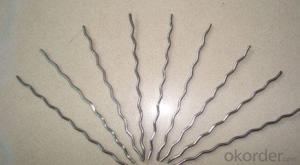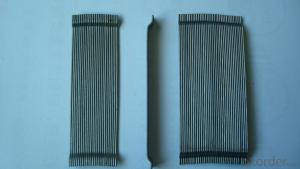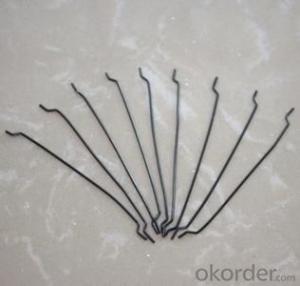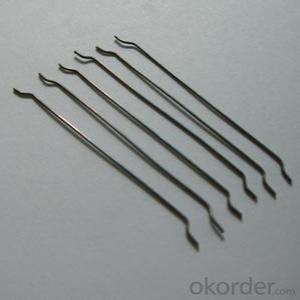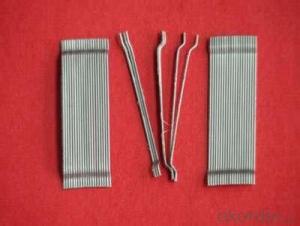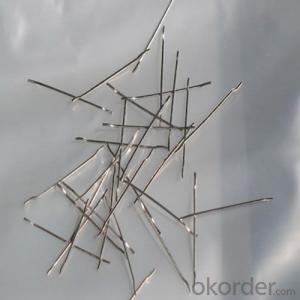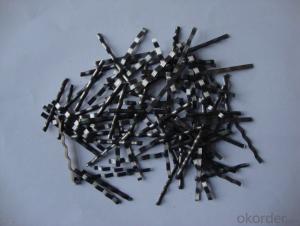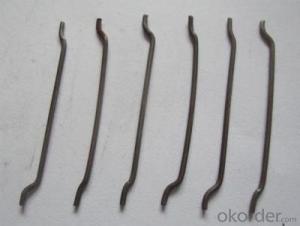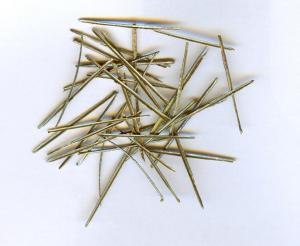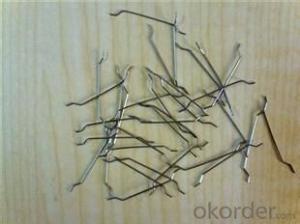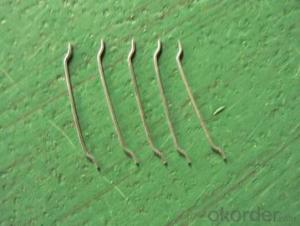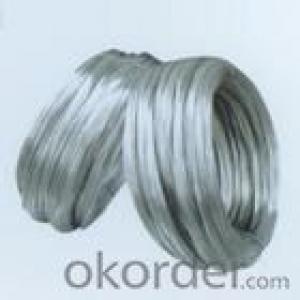Melt Extract Stainless Steel Fiber Glued Steel Fiber from CNBM China
- Loading Port:
- Tianjin
- Payment Terms:
- TT OR LC
- Min Order Qty:
- 1 m.t.
- Supply Capability:
- 5000 m.t./month
OKorder Service Pledge
Quality Product, Order Online Tracking, Timely Delivery
OKorder Financial Service
Credit Rating, Credit Services, Credit Purchasing
You Might Also Like
Quick Details
Place of Origin: Tianjin, China (Mainland)
- Model Number: 0.9
Material: Steel
Production Process: Cold drawn
Lengh: 60
Type: 1
Compressive Strength: >1200MPa
Aspect ratio: 66
Standard: ASTM A820M-11
Section Shape: Circular
Application: Concrete Reinforcement
Packaging & Delivery
| Packaging Details: | 20 kg/Bag,50 bags/Pallet or 1,000kg/ Bulk Bag |
|---|---|
| Delivery Detail: | 1 Month |
Product Description
| Diameter | 0.75 mm | ||
| Length | 60 mm | ||
| Aspect Ratio | 80 | ||
| Tensile strength | 1200 MPa | ||
| Type | Cold drawn Steel Fiber | ||
| End | Hooked-end Steel Fiber | ||
| Glued/Loose | Glued Steel Fiber | ||
| Bending Angle | 45°(min.30°) | ||
| Usage & Performance | Floor:Trafficked areas and Industrial floors | ||
| Shotcrete :Slope stabilization and Final lining | |||
| Precast concrete:Pipe and Railway sleepers | |||
| Packing | Standard Export Pallet Packing | Bag Packing | 20 kg/Bag,50 bags/Pallet |
| Bulk Packing | 1,000kg/ Bulk Bag | ||
| Loading Quantity | 20’GP | 20-25 Tonne/Tonnes | |
| 40’GP | 25-27 Tonne/Tonnes | ||
| 40’HQ | 25-27 Tonne/Tonnes | ||
| MOQ | 1 kg for trial order | ||
| Supply Ability | 10,000 Tonne/Tonnes per Year | ||
| Payment Terms | T/T or L/C at sight | ||
| Delivery Time | Within 15 days after receiving deposit or original L/C at sight | ||
| Certification | ISO9001:2000, CE, | ||
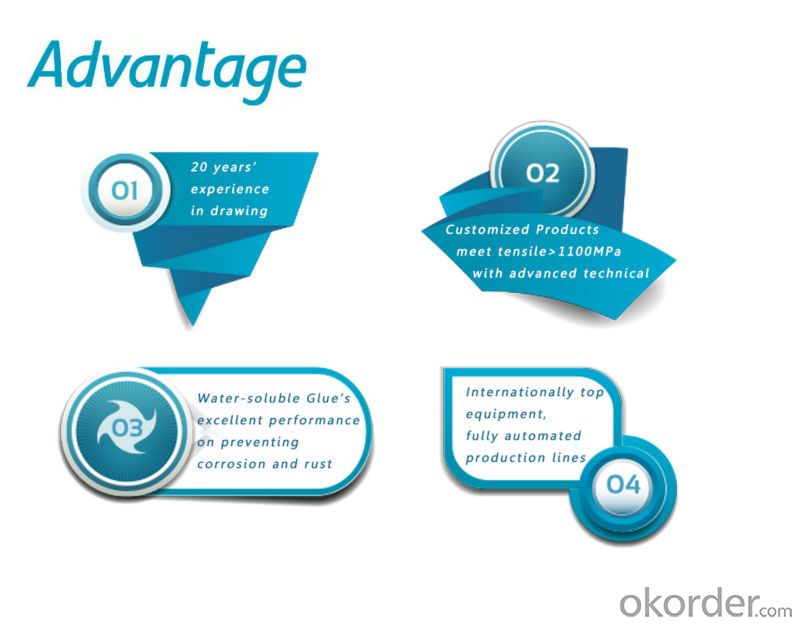
| Product | Diameter (mm) | Length (mm) | Aspect Ratio | Type | Packing |
| G-6030 | 0.5 | 30 | 60 | Glued | 20 kg/Bag, or 1,000kg/ Bulk Bag |
| G-6535 | 0.55 | 35 | 65 | Glued | 20 kg/Bag, or 1,000kg/ Bulk Bag |
| G-6035 | 0.6 | 35 | 60 | Glued | 20 kg/Bag, or 1,000kg/ Bulk Bag |
| G-8060 | 0.75 | 60 | 80 | Glued | 20 kg/Bag, 50 bags/Pallet |
| G-6060 | 0.9 | 60 | 60 | Glued | 20 kg/Bag, 50 bags/Pallet |
| G-6030 | 0.5 | 30 | 60 | Loose | 20 kg/Bag, or 1,000kg/ Bulk Bag |
| G-6535 | 0.55 | 35 | 65 | Loose | 20 kg/Bag, or 1,000kg/ Bulk Bag |
| G-6035 | 0.6 | 35 | 60 | Loose | 20 kg/Bag, or 1,000kg/ Bulk Bag |
| G-8060 | 0.75 | 60 | 80 | Loose | 20 kg/Bag, 50 bags/Pallet |
| G-6060 | 0.9 | 60 | 60 | Loose | 20 kg/Bag, 50 bags/Pallet |
- Q: Does the addition of melt extract stainless steel fiber affect the workability of concrete?
- The workability of concrete can be affected by the inclusion of melt extract stainless steel fiber. Adding stainless steel fibers to concrete can increase its viscosity and reduce its flowability, making it less fluid and more challenging to work with, particularly during pouring and placement. Stainless steel fibers serve as reinforcement in the concrete matrix, enhancing its tensile strength and durability while reducing the risk of cracking. However, the introduction of these fibers can also decrease workability, making it difficult to achieve the desired level of compaction and finish. To address this issue, it is advisable to adjust the concrete mix design by modifying the water-cement ratio or incorporating superplasticizers. These adjustments can enhance workability and ensure proper placement and finishing of the concrete, even when melt extract stainless steel fiber is added. It is crucial to carefully consider the specific properties and requirements of the concrete project to strike the right balance between workability and reinforcement.
- Q: How does the addition of melt extract stainless steel fiber affect the impact strength of concrete?
- Concrete's impact strength can be greatly improved by adding melt extract stainless steel fiber. These fibers, known for their strength and durability, are mixed into concrete to enhance its mechanical properties. When combined with concrete, these fibers create a three-dimensional network that enhances the material's toughness. Acting as a reinforcement system, this network absorbs and redistributes energy generated during impact events, reducing the risk of cracking and fracture. The use of stainless steel fibers in concrete increases its flexural strength and ductility, enhancing its resistance to impact loads. This means that the concrete can withstand sudden or repeated impacts without compromising its structural integrity. Additionally, the inclusion of stainless steel fibers improves the overall durability of the concrete. Stainless steel is highly resistant to corrosion and oxidation, making it an excellent material for reinforcing concrete structures. By incorporating these fibers, the concrete becomes more resistant to environmental factors, such as moisture and chemical attacks, which can weaken the material over time. In summary, adding melt extract stainless steel fiber to concrete significantly improves its impact strength by enhancing its toughness, resistance to cracking, and overall durability. This makes it a valuable addition for applications involving high impact loads, such as industrial floors, pavements, and structures in seismic zones.
- Q: Can melt extract stainless steel fiber be used in high-density concrete?
- Yes, melt extract stainless steel fibers can be used in high-density concrete. These fibers are known for their high strength and corrosion resistance, making them suitable for reinforcing concrete in demanding applications. The addition of these fibers can enhance the overall performance and durability of high-density concrete.
- Q: Can melt extract stainless steel fiber reduce the risk of spalling in high-strength concrete?
- The inclusion of melt extract stainless steel fibers in high-strength concrete is beneficial for preventing spalling. Spalling is a common issue in high-strength concrete, especially when it is exposed to high temperatures or fire. The utilization of stainless steel fibers enhances the concrete's capacity to withstand thermal stresses and prevents spalling. Stainless steel fibers possess exceptional mechanical properties, such as high tensile strength and corrosion resistance. These fibers reinforce the concrete matrix and enhance its overall durability when incorporated into high-strength concrete. They act as a reinforcement, evenly distributing the load and minimizing the risk of cracking and spalling. The unique characteristics of melt extract stainless steel fibers make them highly effective in preventing spalling. These fibers are typically very fine with diameters ranging from 0.1 to 0.3 mm. This allows for easy dispersion and even distribution throughout the concrete mixture, effectively reinforcing the entire structure. Furthermore, stainless steel fibers have a high melting point and excellent thermal conductivity. When exposed to high temperatures, the fibers dissipate heat and decrease the thermal gradients within the concrete. This prevents the formation of internal stresses that can result in spalling. In conclusion, the addition of melt extract stainless steel fibers to high-strength concrete significantly reduces the risk of spalling. These fibers reinforce the matrix, enhance its resistance to cracking, and improve its ability to withstand thermal stresses. By preventing spalling, the concrete's structural integrity and longevity are improved, resulting in a safer and more durable material.
- Q: What is steel fiber? What's the use of it?
- Compared with ordinary concrete, not only can improve the tensile, shear, bending, anti-wear and anti cracking performance, but also can greatly enhance the fracture toughness of concrete and impact resistance, improve fatigue properties and durability of structures. Especially the toughness can be increased L020 times.
- Q: Can melt extract stainless steel fiber be used in architectural concrete?
- Indeed, melt extract stainless steel fiber is a viable option for incorporating into architectural concrete. Its utilization is widespread in architectural concrete projects owing to its impressive strength and durability. By reinforcing the concrete, it aids in bolstering its resistance against cracking, shrinkage, and impact, thereby augmenting the overall performance and lifespan of the structures. Moreover, the inclusion of melt extract stainless steel fiber in architectural concrete also fortifies its resistance against corrosion, rendering it suitable for implementation in architectural endeavors that face exposure to harsh environmental conditions. In summary, the integration of melt extract stainless steel fiber into architectural concrete not only enhances its structural integrity but also elevates its aesthetic allure.
- Q: What is the effect of melt extract stainless steel fiber on the modulus of plasticity of concrete?
- The effect of melt extract stainless steel fiber on the modulus of plasticity of concrete is that it enhances the overall flexural strength and ductility of the material. When added to the concrete mix, these stainless steel fibers act as reinforcement, strengthening the concrete and increasing its ability to withstand bending forces without fracturing. The presence of these fibers in the concrete matrix helps to distribute the load more evenly, preventing the formation and propagation of cracks. This results in an improved modulus of plasticity, which refers to the material's ability to deform under stress without permanent deformation or failure. By increasing the modulus of plasticity, melt extract stainless steel fibers contribute to a more durable and resilient concrete structure. Furthermore, these fibers also enhance the post-cracking behavior of concrete. Even after the concrete has cracked under load, the stainless steel fibers help to hold the cracked sections together, limiting further crack propagation. This enhances the overall performance of the concrete by increasing its resistance to fatigue and minimizing the potential for sudden failure. In summary, the inclusion of melt extract stainless steel fibers in concrete positively affects the modulus of plasticity by improving flexural strength, ductility, and crack resistance. This leads to a more resilient and durable concrete structure capable of withstanding higher loads, reducing maintenance requirements, and extending the service life of the construction project.
- Q: What is the effect of melt extract stainless steel fiber on the modulus of elasticity of concrete?
- The inclusion of melt extract stainless steel fibers in concrete generally increases the modulus of elasticity. These fibers help in improving the tensile strength and stiffness of the concrete matrix, resulting in a higher modulus of elasticity.
- Q: What is the effect of melt extract stainless steel fiber on the thermal conductivity of concrete?
- The thermal conductivity of concrete can be greatly improved by incorporating melt extract stainless steel fiber. Stainless steel fibers possess excellent thermal conductivity properties, enabling them to effectively transfer heat throughout the concrete. When these fibers are added to the concrete mixture, they create a three-dimensional network that aids in the efficient conduction and distribution of heat. This enhanced thermal conductivity has multiple positive impacts on the performance of the concrete. To begin with, the heightened thermal conductivity can enhance the overall thermal efficiency of structures constructed with this particular type of concrete. It facilitates better heat transfer, leading to more efficient temperature regulation and reducing the need for additional insulation or heating and cooling systems. Furthermore, the improved thermal conductivity can also enhance the durability of the concrete. By evenly distributing heat and minimizing temperature variations, the risk of thermal cracking and damage due to expansion and contraction is diminished. This is particularly advantageous in environments with substantial temperature fluctuations. Moreover, the greater thermal conductivity provided by melt extract stainless steel fiber can also be beneficial in applications like radiant floor heating systems. The fibers effectively transfer heat from the heating elements to the surface, resulting in more efficient and effective heating. In conclusion, the incorporation of melt extract stainless steel fiber in concrete significantly improves its thermal conductivity. This improvement leads to increased thermal efficiency, enhanced durability, and improved performance in various applications where heat transfer is crucial.
- Q: Does melt extract stainless steel fiber improve the fatigue resistance of concrete?
- Yes, melt extract stainless steel fiber can improve the fatigue resistance of concrete. Stainless steel fibers are known for their high tensile strength and excellent corrosion resistance properties. When added to concrete, these fibers act as reinforcement and help to distribute stress more evenly throughout the material, reducing the likelihood of cracking and failure under cyclic loading conditions. The addition of melt extract stainless steel fiber to concrete can significantly enhance the fatigue resistance of the material. The fibers help to absorb and dissipate energy during loading and unloading cycles, thereby reducing the accumulation of microcracks and increasing the overall durability of the concrete. This improved fatigue resistance is particularly beneficial in structures subjected to repetitive or dynamic loading, such as bridges, pavements, and industrial floors. Furthermore, melt extract stainless steel fibers have a high aspect ratio, meaning they have a relatively large length compared to their diameter. This aspect ratio allows the fibers to effectively bridge across cracks that may occur in the concrete, preventing their propagation and enhancing the overall structural integrity of the material. In summary, the addition of melt extract stainless steel fiber to concrete can greatly improve its fatigue resistance by enhancing its ability to withstand cyclic loading. This reinforcement helps to prevent crack formation and propagation, resulting in a more durable and long-lasting concrete structure.
Send your message to us
Melt Extract Stainless Steel Fiber Glued Steel Fiber from CNBM China
- Loading Port:
- Tianjin
- Payment Terms:
- TT OR LC
- Min Order Qty:
- 1 m.t.
- Supply Capability:
- 5000 m.t./month
OKorder Service Pledge
Quality Product, Order Online Tracking, Timely Delivery
OKorder Financial Service
Credit Rating, Credit Services, Credit Purchasing
Similar products
Hot products
Hot Searches
Related keywords
